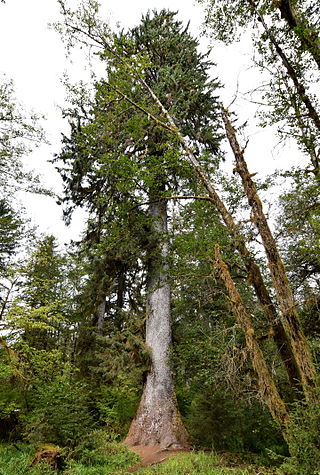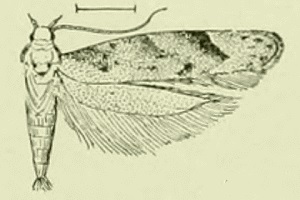
A spruce is a tree of the genus Picea, a genus of about 35 species of coniferous evergreen trees in the family Pinaceae, found in the northern temperate and boreal (taiga) regions of the Earth. Picea is the sole genus in the subfamily Piceoideae. Spruces are large trees, from about 20 to 60 m tall when mature, and have whorled branches and conical form. They can be distinguished from other members of the pine family by their needles (leaves), which are four-sided and attached singly to small persistent peg-like structures on the branches, and by their cones, which hang downwards after they are pollinated. The needles are shed when 4–10 years old, leaving the branches rough with the retained pegs. In other similar genera, the branches are fairly smooth.

Choristoneura is a genus of moths in the family Tortricidae. Several species are serious pests of conifers, such as spruce and are known as spruce budworms.

Picea abies, the Norway spruce or European spruce, is a species of spruce native to Northern, Central and Eastern Europe.

Picea sitchensis, the Sitka spruce, is a large, coniferous, evergreen tree growing to almost 100 meters (330 ft) tall, with a trunk diameter at breast height that can exceed 5 m (16 ft). It is by far the largest species of spruce and the fifth-largest conifer in the world, and the third-tallest conifer species. The Sitka spruce is one of the few species documented to exceed 90 m (300 ft) in height. Its name is derived from the community of Sitka in southeast Alaska, where it is prevalent. Its range hugs the western coast of Canada and the US, continuing south into northernmost California.

Picea rubens, commonly known as red spruce, is a species of spruce native to eastern North America, ranging from eastern Quebec and Nova Scotia, west to the Adirondack Mountains and south through New England along the Appalachians to western North Carolina. This species is also known as yellow spruce, West Virginia spruce, eastern spruce, and he-balsam. Red spruce is the provincial tree of Nova Scotia.

The blue spruce, also commonly known as green spruce, Colorado spruce, or Colorado blue spruce, is a species of spruce tree. It is native to North America, and is found in USDA growing zones 1 through 7. It is found naturally in Arizona, Colorado, Idaho, New Mexico, Utah and Wyoming. It has been widely introduced elsewhere and is used as an ornamental tree in many places far beyond its native range. The blue spruce has blue-green colored needles and is a coniferous tree.

Piceid is a stilbenoid glucoside and is a major resveratrol derivative in grape juices. It can be found in the bark of Picea sitchensis. It can also be isolated from Reynoutria japonica, the Japanese knotweed.

Choristoneura fumiferana, the eastern spruce budworm, is a species of moth of the family Tortricidae native to the eastern United States and Canada. The caterpillars feed on the needles of spruce and fir trees. Eastern spruce budworm populations can experience significant oscillations, with large outbreaks sometimes resulting in wide scale tree mortality. The first recorded outbreaks of the spruce budworm in the United States occurred in about 1807, and since 1909 there have been waves of budworm outbreaks throughout the eastern United States and Canada. In Canada, the major outbreaks occurred in periods circa 1910–20, c. 1940–50, and c. 1970–80, each of which impacted millions of hectares of forest. Longer-term tree-ring studies suggest that spruce budworm outbreaks have been recurring approximately every three decades since the 16th century, and paleoecological studies suggest the spruce budworm has been breaking out in eastern North America for thousands of years.

Piceatannol is the organic compound with the formula ( 2C6H3)2CH)2. Classified as a stilbenoid and a phenol, it is a white solid, although samples often are yellow owing to impurities.

Cydia pactolana, the spruce bark tortrix, is a moth of the family Tortricidae. It is found in central, northern and eastern Europe as well as Siberia. In Japan, the subspecies Cydia pactolana yasudai is present.

Epinotia nanana, the European spruce needleminer, is a moth of the family Tortricidae. It is found from northern and central Europe to Russia and Mongolia.

Syringetin is an O-methylated flavonol, a type of flavonoid. It is found in red grape, in Lysimachia congestiflora and in Vaccinium uliginosum. It is one of the phenolic compounds present in wine.

Coleotechnites piceaella is a moth of the family Gelechiidae. It is found in north-eastern United States and Canada. It is an introduced species in Europe and was first recorded from Great Britain in 1952, then Germany in 1963 and has expanded from there over all of central Europe, towards France, Italy and Hungary.

Astringin is a stilbenoid, the 3-β-D-glucoside of piceatannol. It can be found in the bark of Picea sitchensis or Picea abies.

Picein is a phenolic compound found in mycorrhizal roots of Norway spruces. It is the glucoside of piceol.

Piceol is a phenolic compound found in the needles and in mycorrhizal roots of Norway spruces. Picein is the glucoside of piceol.

Isorhapontigenin is a tetrahydroxylated stilbenoid with a methoxy group. It is an isomer of rhapontigenin and an analog of resveratrol. It is found in the Chinese herb Gnetum cleistostachyum, in Gnetum parvifolium and in the seeds of the palm Aiphanes aculeata.

4-Hydroxybenzoic acid 4-O-glucoside is a glucoside of p-hydroxybenzoic acid. It can be found in mycorrhizal and non-mycorrhizal roots of Norway spruces.

Isorhapontin is a stilbenoid. It is the glucoside of isorhapontigenin. It can be found in mycorrhizal and non-mycorrhizal roots of Norway spruces, in the bark of Picea sitchensis or in white spruce.
Elatobium abietinum, commonly known as the spruce aphid or green spruce aphid, is a species of aphid in the subfamily Aphidinae that feeds on spruce, and occasionally fir. It is native to Northern, Central and Eastern Europe and has spread to Western Europe, North America and elsewhere.



















